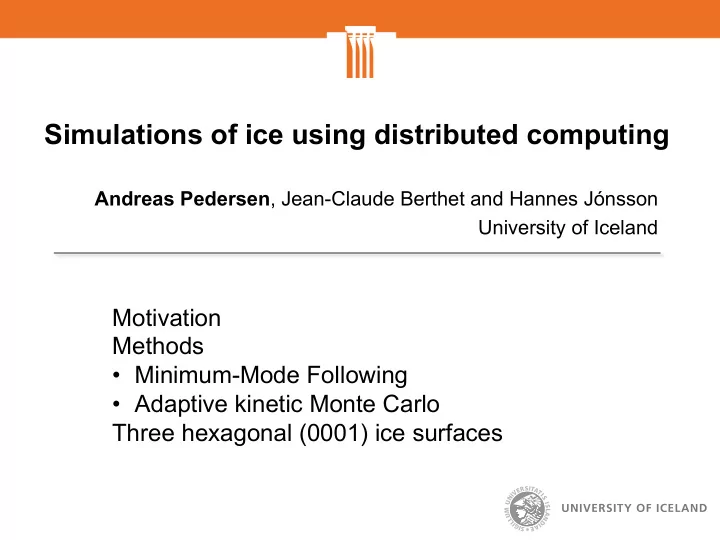

Simulations of ice using distributed computing Andreas Pedersen , Jean-Claude Berthet and Hannes Jónsson University of Iceland Motivation Methods • Minimum-Mode Following • Adaptive kinetic Monte Carlo Three hexagonal (0001) ice surfaces
Water-Ice Rich number of possible phases (more than 10). Hexagonal phase most stable at ambient conditions Hexagonal Ice (I h ) – Oxygen in hexagonal lattice – Ice rule § 4 hydrogen bonds § No dipole moment Protons are disordered – Wide area of interest : – Biology, Chemistry, Geology, Glaciology, … Astronomy: – Cold environment < 200 K – HTST applies Adaptive kinetic Monte Carlo: – Molecular system
Minimum-Mode Following Method Minimum-‑Mode ¡Following ¡Method ¡ – Displace ¡system, ¡using ¡Gaussian ¡random ¡distribu<on ¡ – A ¡climb ¡guided ¡by ¡the ¡Hessian ’ s ¡Minimum-‑Mode ¡ § Minimum-‑Mode ¡can ¡be ¡es<mated ¡using ¡dimer ¡or ¡lanczos ¡method ¡ § Hessian, ¡matrix ¡of ¡second ¡order ¡deriva<ve ¡of ¡the ¡energy ¡ – Loca<ng ¡Saddle ¡Points ¡in ¡an ¡unbiased ¡way ¡ Ref: G. Henkelman and H. Jónsson, J. Chem. Phys. 111, 7010 (1999)
Adaptive Kinetic Monte Carlo – Obtain Table of Events § Locate Saddle Point § Slide down Potential Energy Surface, to determine product § Rate for this mechanism estimated using HTST – KMC pick among mechanisms 3 N min ∏ exp − E SP − E min # & ν i k HTST = i % ( 3 N − 1 k B T SP ∏ $ ' ν i i Ref: G. Henkelman and H. Jónsson, J. Chem. Phys. 115, 9657 (2001)
EON software § Distributed implementation of the adaptive kinetic Monte Carlo method – SP search only relies on the initial displacement – A search should take more than 5 min. § Communicators – BOINC – NORDUgrid – Amazon EC § Implemented at U. Iceland in a collaboration with Henkelman research group (U. Texas, Austin) Ref: A. Pedersen and H. Jónsson, Math. Comput. Simulat. 80, 1487 (2010)
Add H 2 O Molecule on I h (0001) Surfaces Min-mode estimation Lanczos 16 hours 141 states Atomic interactions – TIP4P Inter-molecular § Cut-off 10 Å § Switching region 1 Å § Non-constrained – CCL Intra-molecular Three substrates – 1 add-water molecule – 360 substrate molecules 8 min § Surface area 23 Å X 22 Å 121 states § Bottom bi-layer frozen § 3 surface bi-layers free Temperature 100 K 5 sec 183 states
Annealing, I h (0001) Surface Transformation of surface Dangling protons (charged) rearrange to decrease the number of nearest neighbors Blue lines mark dangling protons From area-like ‘disordered’ To line-like ‘ordered’
Annealing, Observed Proton Swapping Blue molecules with dangling proton are swapped, metastable configuration where a molecule is within a hexagonal hole, effective barrier 0.25eV
Diffusion, Effective Barrier At 100K substrate 2 was sufficiently stable for limited resampling (~4 hours). Size of composite states limited to max 8 microstates. The resulting trajectories were highly anisotropic (1D). Backbone energy landscape for migration has been extracted, effective barrier 0.28 eV Rate at 100K and 200K: § 100 meV ~ 10 8 , 10 10 § 280 meV ~ 10 -1 , 10 6
The Fletcher Phase Dangling protons are aligned in rows, DFT calculations by Pan et al. shows it is an energetically 1 millisec favorable configuration 50 millisec Simulations § Sufficiently stable for 0.4 sec extensive resampling (5 mio. KMC steps, 77 states) 11 sec in interval from 100K to 200K § Trajectories are isotropic § Diffusion barrier 0.23eV 15 min Ref: Ding Pan et al. , Phys Rev Lett 101, 155703 (2008)
Conclusions Hexagonal ice surface, annealing – Transforms toward line-like proton order Hexagonal ice surface, barriers – Substrate annealing ~0.25 eV – Add molecule diffusion ~0.25 eV Coarse graining required Supported by The Icelandic Research Fund
Clusters on an I h Surface Energy: -215.02 eV Energy: -215.24 eV Monomer Tetramer Pentamer Dimer Energy: -215.39 eV; Time 2.5 ns Trimer Hexamer Leftmost figure: E. Batista and H. Jónsson, Comp. Mater. Science 20, 325 (2001)
Recommend
More recommend